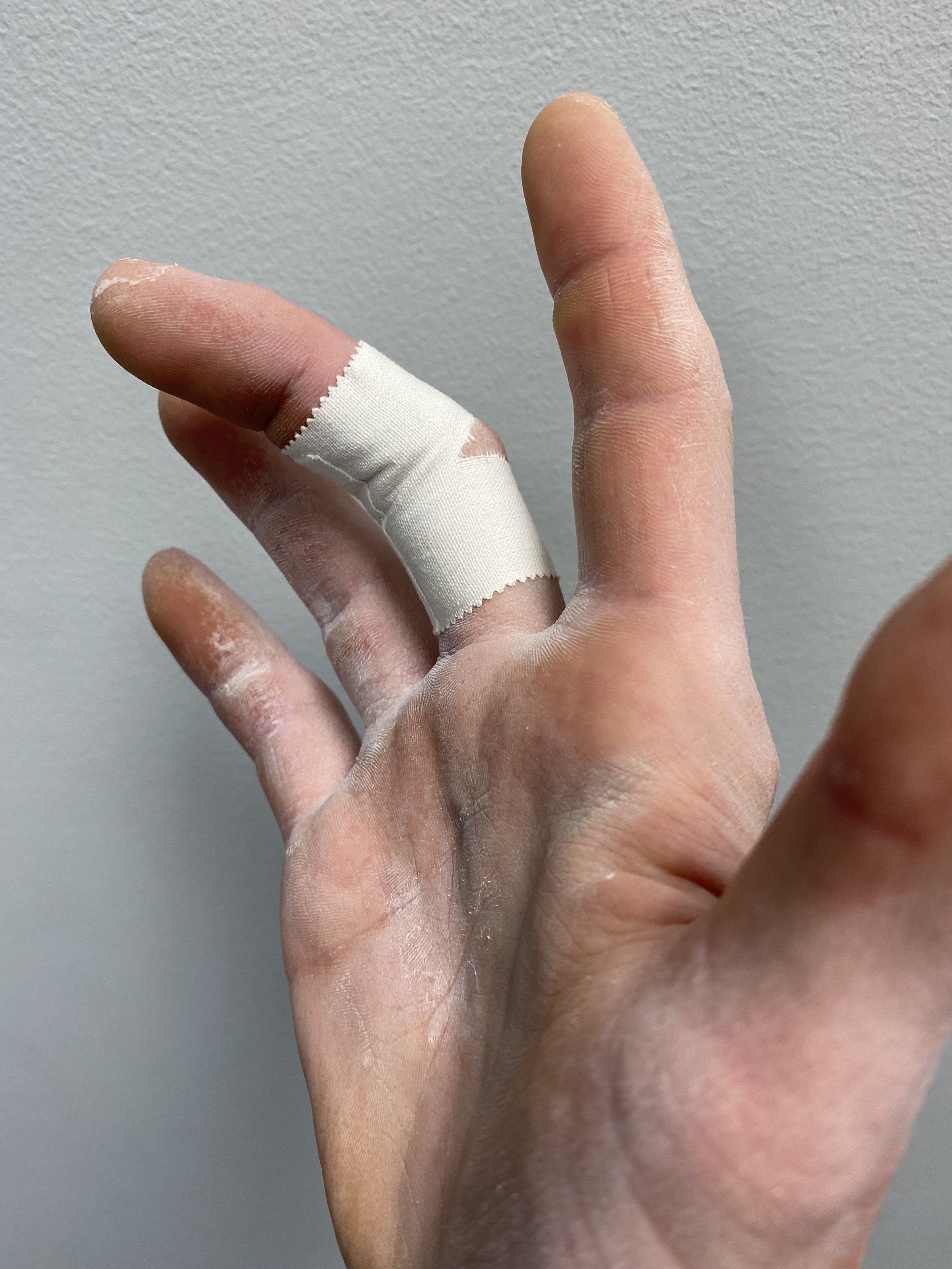As an Amazon Associate, I earn from qualifying purchases.
Climbing tape is used to protect and support the skin on hands and fingers during climbing activities. It is designed to provide grip and prevent blisters, cuts, and abrasions.
Climbing tape is an essential accessory for climbers and boulderers to protect their hands while climbing. It is made of a durable and flexible fabric that sticks firmly to the skin without leaving any residue. The tape is wrapped around the fingers and hands to prevent blisters and protect the skin from cuts and abrasions.
Climbing tape also provides extra grip and support, allowing climbers to maintain a secure grip on the holds. It is available in different widths and colors to suit individual preferences. Climbing tape is an inexpensive and practical solution for climbers to protect their hands and improve their performance.
Introduction To Climbing Tape
Climbing tape is a specialized type of athletic tape used by climbers to protect their hands and fingers while climbing. It helps to prevent blisters, skin tears and other types of injuries that commonly occur in rock climbing. Climbing tape is also used to improve grip and provide additional support to the fingers and hands.
Brief History
Originating from the world of rock climbing, climbing tape has evolved into a versatile tool used by climbers of all levels.
Initially used for minor cuts and abrasions, climbing tape is now a staple in every climber’s gear bag for various applications.
Types And Varieties
Climbing tape comes in different types, including finger tape, hand tape, and knee tape, each designed for specific needs.
Finger tape is thin and flexible, providing support and protection to finger tendons during climbs.
Hand tape is wider and offers extra grip and protection to the palms and back of the hands.
Knee tape is sturdy and helps stabilize and protect the knee joints during demanding climbs.

Credit: m.youtube.com
Essential Qualities Of Climbing Tape
Climbing tape is a crucial accessory for climbers, providing support and protection during climbs. Understanding the key qualities of climbing tape can help you choose the right one for your needs.
Adhesive Strength
The adhesive strength of climbing tape is vital for ensuring it stays in place during strenuous climbs.
Durability And Flexibility
Climbing tape needs to be durable to withstand the rigors of climbing while still being flexible enough to move with your body.
Grip Enhancement With Climbing Tape
When it comes to climbing, having a strong and reliable grip is essential for success. Climbing tape is a versatile tool that can be used to enhance grip, prevent injuries, and provide support during climbs. In this article, we will explore the various ways in which climbing tape can be used to improve grip and traction, as well as the best techniques for applying tape effectively.
Improving Hold Traction
Climbing tape serves as an effective aid in improving hold traction during climbs. Its adhesive properties and durable texture provide enhanced grip, especially when tackling challenging routes or boulders.
Techniques For Tape Application
Proper application of climbing tape is crucial for maximizing its benefits. When applying the tape, ensure that it is wrapped securely around the fingers, hands, or other areas requiring support. This will help to provide the necessary stability and grip during climbs, reducing the risk of slipping and enhancing overall performance.

Credit: www.mendcolorado.com
Protection Strategies
Climbing tape is a crucial accessory for climbers, providing essential support and protection during ascents. Utilizing protection strategies when using climbing tape can help prevent injuries and discomfort, ensuring a safer and more enjoyable climbing experience.
Preventing Blisters And Cuts
When climbing, the hands are subject to repetitive friction and pressure, which can result in painful blisters and cuts. Properly applying climbing tape to vulnerable areas such as fingertips and palms can effectively prevent these issues, allowing climbers to maintain their grip without the risk of injury.
Support For Fingers And Wrists
Climbing tape serves as a valuable tool for providing support to fingers and wrists, reducing the risk of strains and sprains during challenging climbs. By applying the tape strategically, climbers can stabilize joints and muscles, enhancing their overall performance and minimizing the potential for injuries.
Climbing Tape In Injury Management
Climbing tape is a crucial tool in injury management for climbers, providing support, stability, and protection for the fingers, hands, and wrists. Whether used preventatively or in response to an injury, climbing tape offers climbers the ability to continue training and climbing with minimized discomfort and risk of exacerbating existing injuries.
Temporary Fixes For Pulley Injuries
Pulley injuries are a common concern for climbers, often resulting from overuse or sudden stress on the fingers. Climbing tape can provide a temporary solution by immobilizing the injured finger, reducing the strain on the affected pulley and promoting healing. By creating a customized splint using climbing tape, climbers can protect the injured area while still maintaining some dexterity in the unaffected fingers, allowing them to continue climbing with reduced risk of further damage.
Compression And Support
When dealing with minor sprains or strains, climbing tape can be used to provide compression to the affected area, reducing swelling and promoting faster recovery. The tape offers structural support, stabilizing the injured joint or muscle and allowing climbers to continue their activities with a reduced risk of aggravating the injury. Additionally, the pressure from the tape can help alleviate discomfort and enable climbers to maintain a better grip during their climbs.
Selecting The Right Tape For Climbing
When it comes to climbing, selecting the right tape is crucial for ensuring a secure and comfortable grip. Climbing tape, also known as finger tape or sports tape, is commonly used by climbers to protect their hands and fingers from abrasions, cuts, and blisters. It provides additional support to the tendons and ligaments, aiding in injury prevention and allowing climbers to push their limits.
Material Considerations
When selecting climbing tape, it’s essential to consider the material it’s made from. Most climbing tapes are made from durable, elastic materials such as cotton, synthetic blends, or a combination of both. Each material offers different levels of breathability, flexibility, and adhesive strength, catering to individual preferences and specific climbing needs.
Width And Thickness
The width and thickness of climbing tape play a significant role in its effectiveness. Thicker tapes provide more robust support and protection, ideal for taping larger areas or providing additional stability to joints. On the other hand, narrower tapes are suitable for precision taping of smaller areas, allowing for a more natural feel and dexterity while climbing.
Application Tips And Tricks
Climbing tape is a crucial tool in every climber’s kit, providing support and protection during climbs. Understanding the best practices for applying climbing tape can enhance your climbing experience significantly. Here are some valuable tips and tricks to maximize the effectiveness of climbing tape:
Clean And Dry Surface
- Before applying climbing tape, ensure the skin is clean and dry to promote adhesion.
- Use an alcohol wipe to remove any oils or dirt from the skin for better tape adherence.
- Allow the skin to air dry completely before applying the tape to prevent slippage.
Layering Technique
- Apply an anchor strip of climbing tape to secure the ends and provide a base for additional layers.
- Layer the tape in a crisscross pattern for optimal support and stability during climbs.
- Ensure each layer overlaps slightly to create a secure and durable taping system.
Maintenance And Care
Climbing tape is an essential tool for protecting hands during climbs. It is used to wrap around fingers and other areas of the hand to prevent blisters, cuts, and other injuries. Proper maintenance and care of the tape is important to ensure its effectiveness.
Maintaining climbing tape is crucial for its effectiveness and longevity. Proper care ensures it remains sticky and durable during climbs.Cleaning Used Tape
To clean used tape, gently remove dirt and sweat with a damp cloth. Avoid soaking to prevent weakening the adhesive.Storage For Longevity
Store climbing tape in a cool, dry place away from direct sunlight to maintain its adhesive properties. Keep it sealed in a ziplock bag for extended durability.Alternatives To Traditional Climbing Tape
Modern climbers are exploring innovative taping products beyond traditional climbing tape. These products offer unique features and benefits.
Seeking alternatives, climbers are turning to natural grip enhancers. These products provide environmentally friendly solutions for enhancing grip strength.

Credit: frictionlabs.com
Legal And Ethical Considerations
Legal and ethical considerations play a crucial role in the use of climbing tape. It is important for climbers to be mindful of the impact of tape debris on the environment and to adhere to climbing ethics and best practices.
Tape Debris And Environmental Impact
Climbing tape, while serving a practical purpose, can contribute to environmental degradation if not disposed of properly. The residue from used tape can accumulate in climbing areas, impacting the natural landscape and wildlife. Climbers must be diligent in disposing of tape waste responsibly to minimize its environmental footprint.
Climbing Ethics And Best Practices
When using climbing tape, it is essential for climbers to uphold ethical standards and best practices. This includes respecting climbing area regulations, minimizing impact on the natural environment, and promoting a culture of conservation. Climbers should also prioritize safety, ensuring that the use of tape is in line with ethical guidelines and does not compromise the integrity of the climbing experience for others.
Frequently Asked Questions
When Should You Use Climbing Tape?
Climbing tape is used to support and protect the skin on your hands and fingers during climbing. It provides extra grip, prevents blisters, and supports injured or weak joints. Use climbing tape when you need extra support, protection, or grip during climbing activities.
Why Do Climbers Put Tape On Their Fingers?
Climbers put tape on their fingers to protect them from cuts, scrapes, and blisters while climbing. It provides additional support and stability to the fingers during challenging climbs.
Does Tape Help With Rock Climbing?
Yes, tape can help with rock climbing by providing extra grip and protecting your skin from abrasions and cuts.
Why Do Rock Climbers Tape Their Wrists?
Rock climbers tape their wrists to provide extra support and stability during climbs, preventing injuries and improving grip strength.
Conclusion
Climbing tape is a versatile tool for both beginner and advanced climbers. It provides support, protection, and stability, making it an essential addition to any climber’s gear. Whether used for injury prevention or to improve grip, climbing tape is a valuable asset for enhancing performance and ensuring safety during climbing activities.
As an Amazon Associate, I earn from qualifying purchases.
